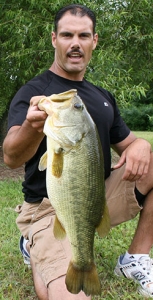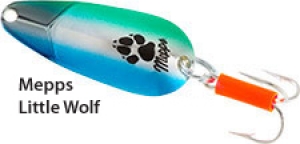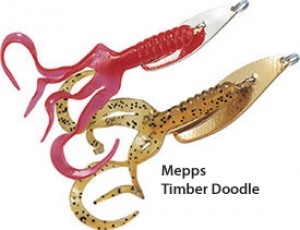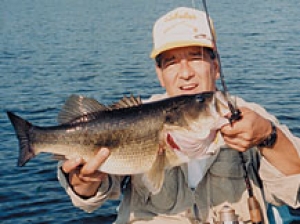 The largemouth bass is one of the most sought after game fish in North America. It thrives in shallow weedy lakes and river backwaters, as its basic food supply is available in these areas. Also, aquatic plants and sunken debris furnish protection.
The largemouth bass is one of the most sought after game fish in North America. It thrives in shallow weedy lakes and river backwaters, as its basic food supply is available in these areas. Also, aquatic plants and sunken debris furnish protection.
Bass spawn in the spring when water temperatures reach 62-65 degrees. This can be from May to late June depending on the part of the country. Nesting usually occurs within seven to eight feet of shore in one to three feet of water. These nesting areas are bass “hot spots.” Don’t pass them up as spring is one of the best times to tie into a trophy bass.
Growth rate varies from one part of the country to another. Southern bass grow fast and can weigh 20 pounds or more. Northern bass hardly ever go over 10 pounds, and a three pounder is considered a good fish.
The largemouth is an ornery critter feeding on anything it thinks is alive, including frogs, crayfish, insects and minnows. It can distinguish colors and recent studies indicate it prefers red, yellow, silver and black.
 Spinners and spoons are very effective lures for taking trophy bass. The flash and vibration created by a spinner excites a bass into striking, so he does not have to be “on the feed” to take the lure. Spoons, to a bass, are minnows, so a 1/4 oz. Little Wolfis ideal for big bass. Try to match the size of the spoon to the size of the baitfish. Whenever possible, select a lure color that comes close to the color of the baitfish in your lake.
Spinners and spoons are very effective lures for taking trophy bass. The flash and vibration created by a spinner excites a bass into striking, so he does not have to be “on the feed” to take the lure. Spoons, to a bass, are minnows, so a 1/4 oz. Little Wolfis ideal for big bass. Try to match the size of the spoon to the size of the baitfish. Whenever possible, select a lure color that comes close to the color of the baitfish in your lake.
Big bass hang out in heavy cover, so you’ll need a medium-heavy to heavy rod and a reel that’ll hold at least 100 yards of 12-15 pound test line. If you are fishing with a spinner, tie it directly to your line. Attach a Syclops spoon with a snap swivel. A swivel will impair the action of a spinner, but allow a spoon to swing freely from side to side.
 During the spring and fall fish the shallows as these areas warm up first. At this time you'll want to use smaller lures. You'll also want to slow dowm your retrieve. Try the following...
During the spring and fall fish the shallows as these areas warm up first. At this time you'll want to use smaller lures. You'll also want to slow dowm your retrieve. Try the following...
#2 or #3Aglia
#2 or #3Black Fury
#0 or #1 Timber Doodle
#1 or #2 Comet Mino
#0 or
#1 Syclops
1/4 oz. Little Wolf
Once the water has warmed, look for bass in heavy weeds, lily pads or under the cover of fallen timber. During the dog days of summer big bass have a tendency to hole-up in deep water and can be difficult to find. Fish in and around sunken brush piles or flooded timber with a #3or #4 Mepps spinner, #1 or #2 Syclops, or a #0 Timber Doodle.If you want to fish a little deeper, try a Mepps DeepRunner, its willow leaf blade and heavy torpedo-shaped body lets you work deep holes effortlessly.
 Vertical jigging is a great way to consistently take summertime bass. Anchor your boat upwind and slightly to one side of your target area. Work a1/8 oz. or 1/4 oz. Little Wolf or a #0 or #1 Syclops spoon vertically by holding your rod tip low, shaking it from side to side lightly with an occasional short upward flip. This technique can be very effective when you’re fishing thick cover with lots of snags.
Vertical jigging is a great way to consistently take summertime bass. Anchor your boat upwind and slightly to one side of your target area. Work a1/8 oz. or 1/4 oz. Little Wolf or a #0 or #1 Syclops spoon vertically by holding your rod tip low, shaking it from side to side lightly with an occasional short upward flip. This technique can be very effective when you’re fishing thick cover with lots of snags.